Content audits can be very powerful and restorative, yet many content marketers and SEOs underestimate it, be it for its complexity, or its rather lengthy process. But if you want your content to perform, you should run a content audit from time to time.
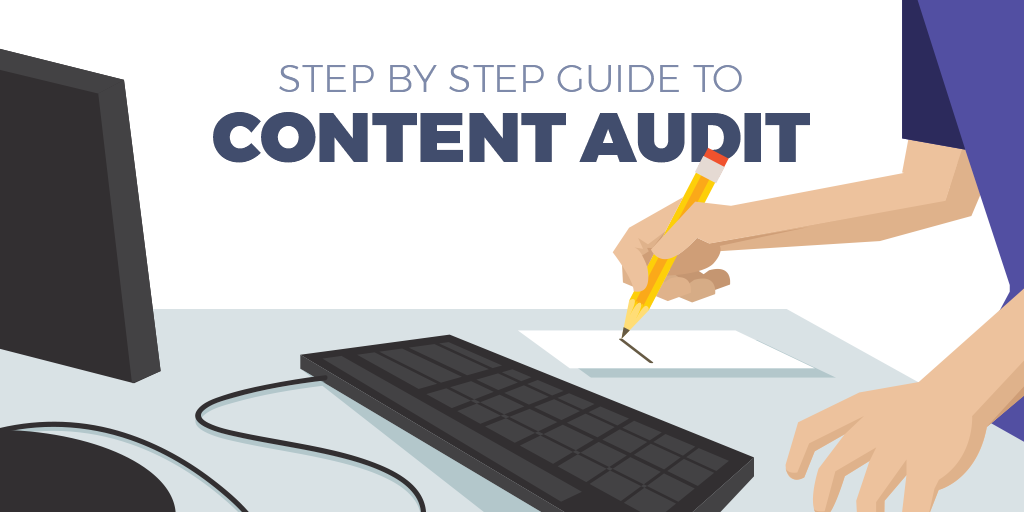
It’s like those annual physical exams you take at the doctor’s. You know they are time-consuming and rather unpleasant, yet results are eye-opening and eventually rewarding. You benefit from knowing what’s to improve, what’s to remove, and what’s working at its best. It’s both a worry relief and a step forward to improving your content.
How many times did you publish a blog post and then left it where it was, without going back to check it for years in a row? No doubt many of us fall into this category. Good practice demands that we do constant repetitive checks so to provide a fresh, updated and charming content all the way to the bottom.
Quick Summary of a Content Audit
Before we launch in a whole WH questions and answers series, there are some things that help set the right introductory atmosphere.
A content audit is meant to bring more performance, more quality, and better rankings and conversions to the content published on your website. In short, deploying a content audit will help both your SEO and content marketing efforts in boosting your business.
The audit process should be based on previously set KPIs in order to extract as much as possible from the available data and make good use of it. Contrary to common feeling, a content audit doesn’t necessarily have to go by the book. It is not an all-or-nothing process but a flexible one, always depending on your aims and goals.
Talking of data, the content audit is a qualitative analysis, and not a quantitative one, actually, known as content inventory. By engaging the former, you get to focus on content quality, customer and user experience, and content performance.
There are times when content audits can go terribly wrong when not done right. It’s not because of you set objective and goals, but rather because of their absence or, worse, lack of knowledge on what to do with the gathered data.
That’s why we have put together a comprehensive but concise perspective on the content audit. You will find answers to questions like what, who, when, how, with what tools, and why, all uncovering the content audit hidden secrets.
- What Is a Content Audit?
- Who Performs a Content Audit?
- When Do You Perform a Content Audit?
- What Tools Do You Need To Perform a Content Audit?
- How Do You Perform a Content Audit?
- Why Is a Content Audit Important?
- Upgrade Your Content Audit Experience
- Conclusion
1. What is a Content Audit?
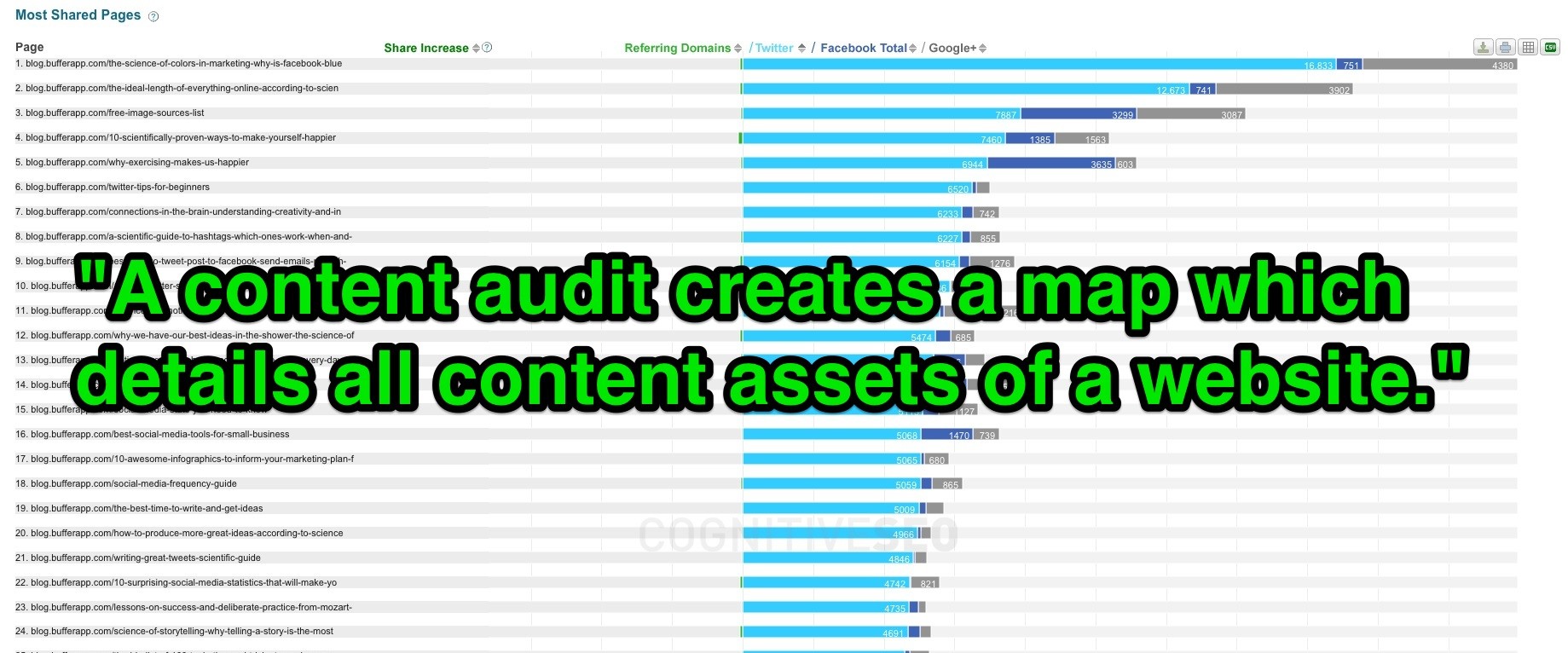
A content audit is a full qualitative inventory of all the indexable content on a domain. URLs are the sole identifier in Google’s index. This is what makes all your published content registered and crawled. Talking of which, it’s a common mistake to remove a content page instead of its search engine indexation when aiming to perform a pruning/removing action (we’ll talk about this later).
Marketers need content audit to get actionable insight on your content marketing strategy. This way, you will learn where you should focus your efforts more and what’s to do next. It helps you find answers to questions like: “Which content is performing best?”, “Which content do customers appreciate and engage with the most?”, and “Which content is already way past its intended glory?”. But as all things come easier when visualized, let’s check the video below:
A content audit lets you see what performs best, thus what’s to keep, what’s to improve, and what’s to remove.
The main purpose of such a process is to improve the overall trust and qualitative services delivered to customers by the domain, optimizing all ranking signals, thus influencing crawl budget, Page Rank flow and much more.
Content may look rather lengthy and comprehensive, but it’s rather easy to track at the core. It mainly comprises 3 stages:
- inventory and audit – it concerns all indexable content, not crawlable content;
- analysis and recommendation;
- summary and reporting.
Whatever reasons you have when deciding not to take it, do it at least annually. It’s time-consuming so you should be ready to undertake it when your time and energy allow it. And also, when you’ll be ready with a clear set of objectives and goals go for it.
2. Who Performs a Content Audit?
There is no specific group of professionals who solely perform content audits. Nevertheless, marketers, SEOs, and content strategists are more prone to do it than others.
There are tens of how-to guides on the internet on how to do a content audit. Yet people with a certain amount of field knowledge couldn’t read results and implement actionable steps better than aficionados or beginners.
3. When Do You Perform a Content Audit?
As previously said, a content audit is not a one-size-fits-all process. There isn’t a specific time when you should engage in a such a process.
However, most times it’s relevant to try an audit once you’ve you gathered some content history in your blog section. Or your domain has already been introduced to at least one applied content marketing strategy.
But most often marketers deploy a content audit when – guess what – they do need one. You need that actionable insight on how your content is performing and how your business is, broadly speaking.
Frankly speaking, once you find the courage to launch a content audit process you have had already pinpointed some goals.
You want to spot the website content that needs to be updated so to address today’s requirements and not (only) yesterday’s.
Or you look for content that asks for a second check, curation, and copywriting or rewriting for more quality. You even take into account removing limping content from the website if necessary.
Your goal is to gain insight on keywords that get traction, perform best, and eventually attract social signals and leads.
You wish to get down to business and check the keyword optimization score of each piece of content, spot your strongest pages and learn how to use them to their full capacity.
You need to get hands on with content marketing opportunities, and give a second chance to penalized or low-ranking content by recovering or re-editing them.
4. What Tools Do You Need To Perform a Content Audit?
First and foremost, you need yourself. Or a human being, per se. You can do the content audit by yourself alone, although it’s quite a big and sometimes exhaustive step. Or you could share the duty, and delegate some chores to another employee. You should do it patiently, step-by-step, at any given time and pace. Anyhow, you could always give it a try and use research automation tools.
From a starting point, there are plenty of tools to use when performing a content audit. Yet, as you might have guessed, there still are some that are preferred over the others.
Screaming Frog is the most popular go-to tool when it comes to crawling website content. Marketers find it rather comprehensive and satisfying. Screaming Frog can crawl up to 500 URLs with the free subscription version and has all the functionality apart from being able to save a data export. Whenever deploying content analysis, it can provide you details such as page title tag info, anchor text, response time, meta descriptions, URLs, title, title length, meta description and the length of it, major H1 and H2 headings on the page, or word count.
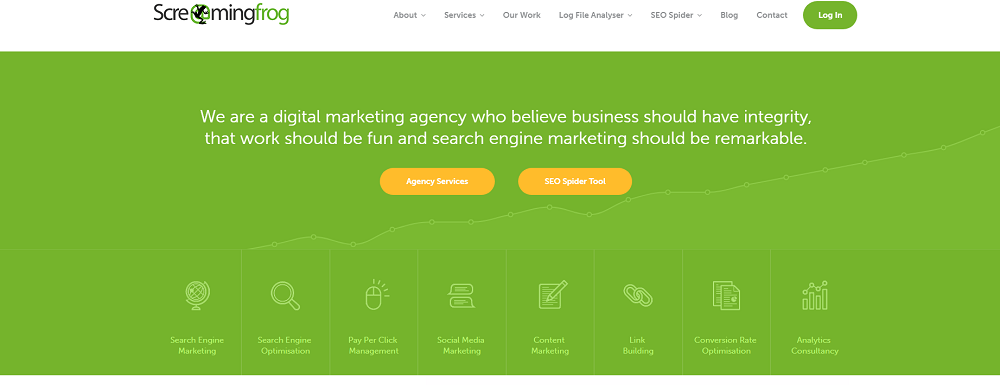
URL Profiler, on the other hand, is a paid crawler, but a popular tool nonetheless. URL Profiler can help you improve your content audit tasks and provide you with raw fresh material for you to analyze on.
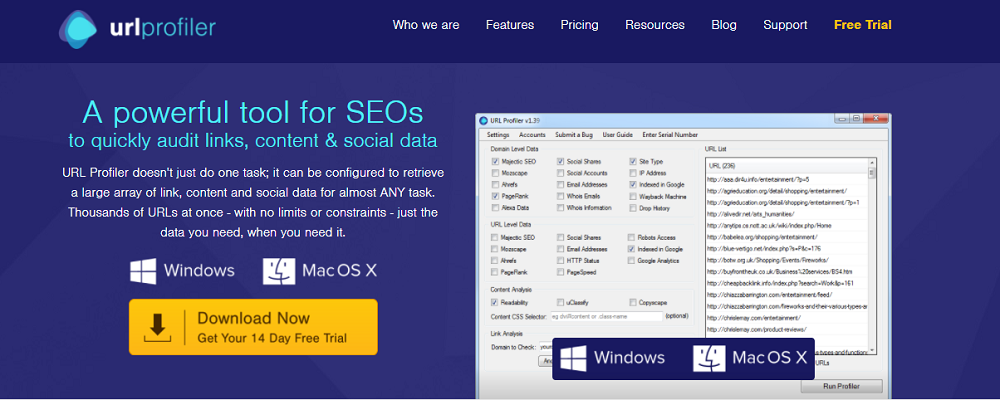
In order to keep work organized and gain a broader view of their website content, SEO’s use Google Analytics for information such as the number of page visits, bounce rate, conversion data by page, time on page and many more.
Apart from the above-mentioned SEO tools, marketers often use Microsoft Excel, Adobe SiteCatalyst, SQL database, and Copyscape or Siteliner tools for checking content uniqueness.
5. How Do You Perform a Content Audit?
This is where the game really begins. In short, a content audit is about making an inventory of all search engine indexed content while following given metrics, and deciding what action is to be taken regarding various pieces and page of content – keep, improve, or remove.
If your website has both desktop and mobile versions, you should do two separate content audits. Although versions share the same URL, the code-base is different – one for mobile, one for desktop.
We’ll dive into some mindful steps to take when deploying a content audit.
First – gather all your data
Open and create an audit spreadsheet. You need it to keep work neat and tidy. Then compile all sitemaps and internal databases, such as all products lists and category URLs. Gather them separately, then organize them all in a single file.
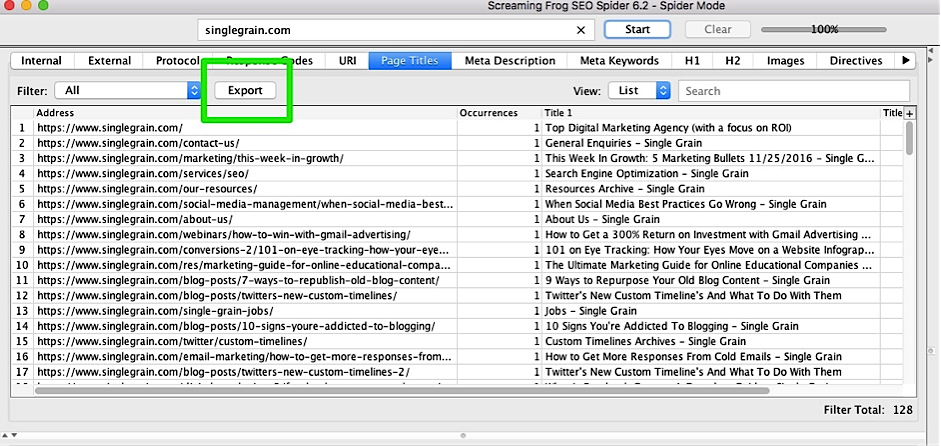
www.singlegrain.com
Now you can start to crawl all indexable URLs. Word of advice: don’t use just a crawler (say, Screaming Frog) as you might easily miss some URLs from the audit, but also Google Analytics and Google Webmaster Tools. After checking this down, filter out URLs that you don’t need to audit, in order to spare yourself from unnecessary work.
Second – consider using more metrics than you’re accustomed
It’s time you considered additional metrics. Search and use some more metrics and information, besides what you already get from crawlers. Apart from titles, descriptions, word count, and meta tags you should check organic search traffic, internal and external links, content uniqueness, conversions, publish date, time-on-site, pages-per-visit, page speed, and mobile friendliness.

blog.alexa.com
Note that time-on-site and pages-per-visit enter a special niche. Be it positive or negative results, they should always be taken with a grain of salt as they can point out to more than one situation. Sometimes customers find the information they’re looking for on your website from the very beginning, which makes them leave as suddenly as they came across you. This automatically influences time-on-site. Similarly, if somebody is satisfied with the information you provided on a page, they might very well feel it’s enough to convince them and no longer check other pages on your website.
Third – use a dashboard
Now that you gathered all the necessary content audit data, it’s time to tidy up. Organize all information in a dashboard. If your site is small, you can do it manually but if it’s larger, you should use Screaming Frog to automatically generate a list of your URLs.
Fourth – do the content audit
This is it. This is where the content audit really shines through. Once you’ve put all the information down in the dashboard, start to perform the content audit on it.
See what content can draw penalties, be it because of its lack of quality and relevancy, or because of the existence of duplicate content. Take each case in turn and treat it wisely. See what needs rewriting, improving, left as-is, or pruning. More on this topic, check this article we published some while ago.
At this stage, you will gain access to a good set of SEO and content marketing data. You will notice patterns and data behavior for SEO metrics such as page title, target keywords, meta descriptions, page visits, last updated date, inbound links, page bounce rate, page entries and exists, average time spent on page, 404 links.
As for content marketing data, you’ll get insight on metrics such as page length, word count, general topic, author, comments, shares, mobile-friendliness, desktop usability, CTA, and page score. Depending on the type of website content – article, blog post, infographic, info page, landing page, publication, news story, FAQ – you can get more or fewer user data and actual feedback on them and also see if it’s outdated or still trendy.
Fifth – get down to action
Decide on a set of steps to take after you complete your content audit. Now it’s time to dive deep into your gathered data, gain insight, draw conclusions, and get down to revolutionizing actions.
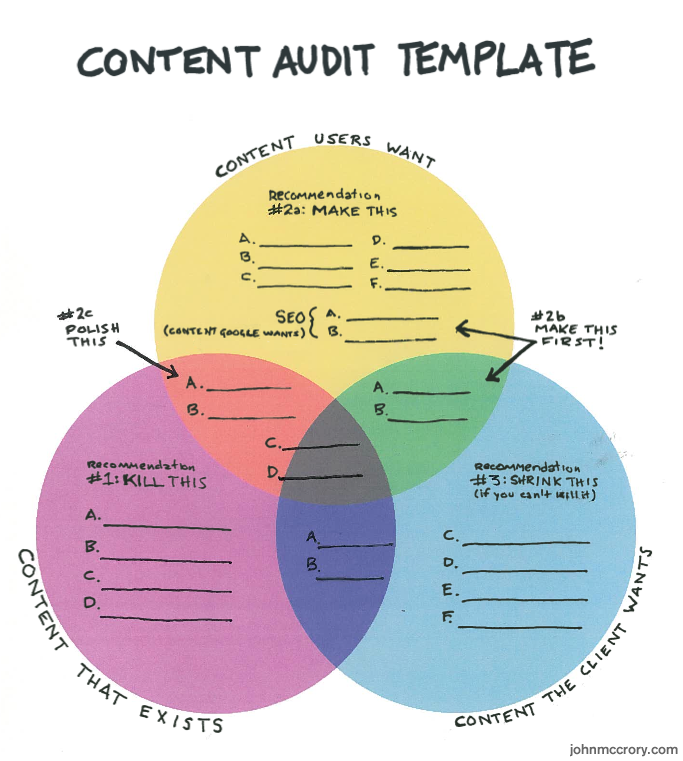
www.contentmarketingup.com
Depending on your set objective and goals, you should focus and do the follow-up action phase after completing a content audit. Rewrite or remove low-quality content pages, go for more promotion with high-performing pages on social media networks, create more trending content pieces similar to the highest-converting ones spotted while content auditing.
Setting to-do lists is one thing, but executing what’s written in them is totally another thing. Wisdom calls that you set deadlines to accomplish your outlined actions. Keep track of yourself and your content marketing strategy.
6. Why Is a Content Audit Important?
Knowing all the assets that exist on a website is important both for a website owner and also for an SEO or digital marketer. Having the documentation of the content audit in handy so you can use it in hard times is essential. Depending on your results, you’ll see what’s to change and what’s to consolidate in your content marketing and SEO efforts.
Also, being able to identify which type of content has worked in the past, which gets the most links, and which gets the most social signals, allows you to plan a future strategy which is based on real actionable data.
A content audit allows for an effective content strategy to be built around it, or even to measure whether the current content strategy is working. This is game-changing both for the popularity of the website and revenue.
From a sales conversions point of view, it can provide you with a clear insight on what content is helping you in your revenue building process. It helps you understand how a visitor navigates and interacts with the website.
A content audit is needed when you want to have a complete idea of the content assets, their usefulness and where gaps needed to be filled. It is also useful in developing future content themes and types.
7. Upgrade Your Content Audit Experience
Spy on your competitors
Now that you’ve got the taste of it, track your competitors’ content performance, identify their content gaps, and use the collected data to your advantage and learning.
When performed against competitor websites, content audits can reveal weaknesses and strengths. If you find that one of your competitors is using a certain type of content extremely successfully, you can analyze it, see whether it fits in with your online marketing strategy, and fold it into the content plan for a test run.
Usually, there will be enough competitors in your marketplace for you to analyze and develop a complete content audit of the whole niche. This is very useful if you wish to dominate the space, it enables you to allow others to test the market with differing types of content, spending money on both success and failure, to allow you to come in and only spend time and energy on what has proven to work. Fill the missing spot in the content industry with the help of actionable data.
With Site Explorer you can see and evaluate the number of links your competitors have. Moreover, you’ll gain valuable insight on who linked them, and whether links come from authoritative domains and pages.


Following the same pattern, you can analyze their best performing content pieces by checking them with Keyword Tool and Content Assistant tool. Check what steps they chose to employ to best optimize their content, how many focus keywords they used. Details such as readability score, words on page, and content performance will provide a deeper look at their strategy.

Interpret social signals
There are many tools available to index and collate the social signals of a website. This is now an essential part of the content audit as it reveals which content works well with the customers.
It’s not just to see whether the crowd likes the content or not, as to see whether the content is promoted properly or not. You can have the best content in the world, but if it is not promoted among social groups, it might be worthless.
What the content audit reveals is crucial information, and can reshape your content strategy. Sometimes, an audit can reveal hidden gems and give ideas of what future content to create, allowing you to increase the ROI of the marketing spend.
Social shares and mentions are very important in the process of triggering links. With BrandMentions you can visualize the number of mentions by day in a set span of time, and how many are on web and which on social media – Twitter. Given you have selected a specific location and language, you can see who and where that specific mention come from.

Links
We need to know which pages have links, where the links are coming from, and how powerful the links are in the eyes of Google. After grasping the needed lessons from both competitors and your site, you can adjust your content marketing strategy for the better.
Site Explorer provides a graphic visualization that enables you to quickly understand the link structure of your site. All the displayed dots are pages that linked to your site. These links bear information worth taking into account. Just hover over them and you gain insight on their link influence, domain influence and date last seen.
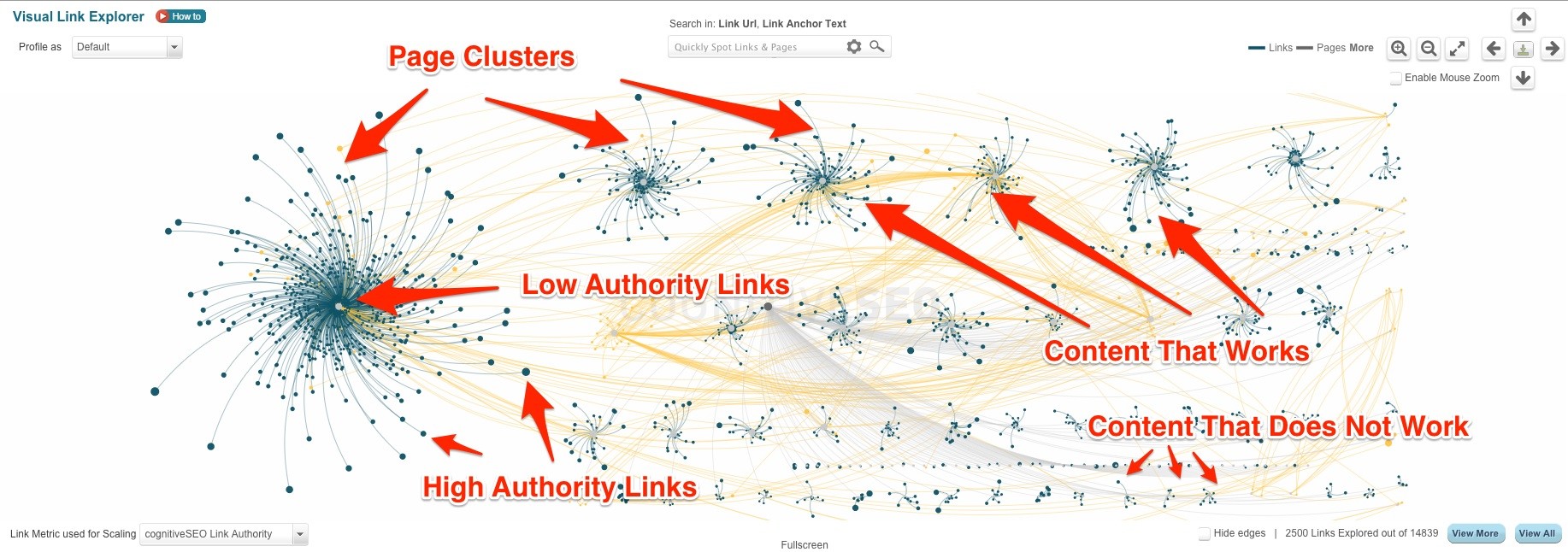
By correlating data we have gathered with the backlink data, we can have access to certain interesting aspects, such as:
- Do specific subjects get more links?
- Are certain promotion techniques better than others at getting links?
- Can social signals trigger links on the world wide web?
- Which specific content types are more popular with social and link building?
- What content should we be concentrating in the future?
Conclusion
Everyone will have their own method of performing a content audit and you should develop the method which works for you best. It’s not a one-off process that you deploy once in a lifetime. You will perform it more than once, and every time things will be different. All depends on your style, your needs, and your goals.
The work flow is just as important as the tools you use. Having a methodology and a process is crucial to ensure that results are reached in an efficient and speedy manner.
The conclusion of the content audit analysis is shaped by what the purpose of the audit was in the first place, thus make sure you have previously defined reasons for performing one.
Beware of the analysis paralysis trap. No doubt everyone is fighting it. There’ll be a point when the data will be abundant, thus so many conclusions to draw and a whole array of actions to deploy, that you’ll probably block or experience fright. Especially when you’re doing it for the first time. Don’t be intimidated by the data. Concentrate on the few metrics that are relevant to you and make sure these are gathered and presented in a logical clear format.
Remember: content audit is an opportunity for you to improve your content marketing processes. So shine on with it!

 Site Explorer
Site Explorer Keyword tool
Keyword tool Google Algorithm Changes
Google Algorithm Changes

Thanks for sharing!
How do you value and measure the content readability? Is Google smart enough to rate the readability of the content in foreign languages other than English?
Best Regards
i read the 1st couple of waffled paragraphs and got bored…get to the point!
This is definately the best content audit guide I have ever read in 2017
Thank you so much.